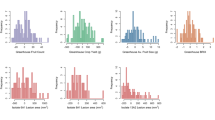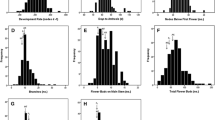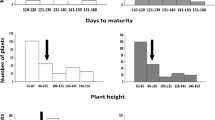Abstract
Approximately 170 BC2 plants from a cross between an elite processing inbred (recurrent parent) and the wild species Lycopersicon pimpinellifolium LA1589 (donor parent) were analyzed with segregating molecular markers covering the entire tomato genome. Marker data were used to identify QTLs controlling a battery of horticultural traits measured on BC2F1 and BC3 families derived from the BC2 individuals. Despite its overall inferior appearance, L. pimpinellifolium was shown to possess QTL alleles capable of enhancing most traits important in processing tomato production. QTL-NIL lines, containing specific QTLs modifying fruit size and shape, were subsequently constructed and shown to display the transgressive phenotypes predicted from the original BC2 QTL analysis. The potential of exploiting unadapted and wild germplasm via advanced backcross QTL analysis for the enhancement of elite crop varieties is discussed.
Similar content being viewed by others
References
Alpert K, Grandillo S, Tanksley SD (1995) fw2.2: a major QTL controlling fruit weight is common to both red and green-fruited tomato species. Theor Appl Genet (in press)
Davies JN, Massey DN, Winsor GW (1958) The effect of defoliating tomato plants on fruit composition. Rpt Glasshouse Crops Res Inst 1957:53–66
Emery GC, Munger HM (1970) Effects of inherited differences in growth habit on fruit size and soluble solids in tomato. J Am Soc Hort Sci 95:410–412
Eshed Y, Zamir D (1995) An introgression line population of Lycopersicon pennellii in the cultivated tomato enables the identification and fine mapping of yield-associated QTLs. Genetics 141:1147–1162
Fisher KJ (1975) Effects of the amount and position of leaf tissue on the yield of single-truss tomatoes. Scien Hort 3:303–308
Goldenberg JB, von der Pahleen A (1966) Genetic and phenotypic correlation between wieght and dry matter content of tomato fruits and their heritabilities. Bol Genetico 2:1–15
Grandillo S, Tanksley SD (1995a) QTL analysis of horticultural traits differentiating the cultivated tomato from the closely related species Lycopersicon pimpinellifolium. Theor Appl Genet (in press)
Grandillo S, Tanksley SD (1995b) Genetic analysis of RFLPs, GATA microsatellites and RAPDs in a cross between L. esculentum and L. pimpinellifolium. Theor Appl Genet (in press)
Hewitt JD, Stevens MA (1981) Growth analysis of two tomato genotypes differing in total fruit solids content. J Am Soc Hort Sci 106:723–727
Ibarbia EA, Lambeth VN (1971) Tomato fruit size and quality interrelationships. J Am Soc Hort Sci 96:199–210
Paterson AH, Lander ES, Hewitt JD, Peterson S, Lincoln SE, Tanksley SD (1988) Resolution of quantitative traits into Mendelian factors by using a complete linkage map of restriction fragment length polymorphisms. Nature 335:721–726
Paterson AH, Damon S, Hewitt JD, Zamir D, Rabinovitch HD, Lincoln SE, Lander ES, Tanksley SD (1991) Mendelian factors underlying quantitative traits in tomato: comparison across species, generations, and environments. Genetics 127:181–197
SAS Institute, Inc (1994) JMP users guide: version 3.0 of JMP. SAS Institute, Carry, N.C.
Stevens MA (1976) Inheritance of viscosity potential in tomato. J Am Soc Hort Sci 101:152–155
Stevens MA, Rudich J (1978) GENETIC potential for overcoming physiological limitations on adaptability, yield, and quality in the tomato. Hort Science 13:673–678
Tanksley SD, Nelson JC (1995) Advanced backcross QTL analysis: a method for the simultaneous discovery and transfer of valuable QTLs from unadapted germplasm into elite breeding lines. Theor Appl Genet (in press)
Tanksley SD, Ganal MW, Prince JP, de Vicente MC, Bonierbale MW, Broun P, Fulton TM, Giovannoni JJ, Grandillo S, Martin GB, Messeguer R, Miller JC, Miller L, Paterson AH, Pineda O, Röder MS, Wing RA, Wu W, Young ND (1992) High-density molecular linkage maps of the tomato and potato genomes. Genetics 132:1141–1160
Young ND, Tanksley SD (1989) Restriction fragment length polymorphism maps and the concept of graphical genotypes. Theor Appl Genet 77:95–101
Author information
Authors and Affiliations
Additional information
Communicated by G. Wenzel
Rights and permissions
About this article
Cite this article
Tanksley, S.D., Grandillo, S., Fulton, T.M. et al. Advanced backcross QTL analysis in a cross between an elite processing line of tomato and its wild relative L. pimpinellifolium . Theoret. Appl. Genetics 92, 213–224 (1996). https://doi.org/10.1007/BF00223378
Received:
Accepted:
Issue Date:
DOI: https://doi.org/10.1007/BF00223378




